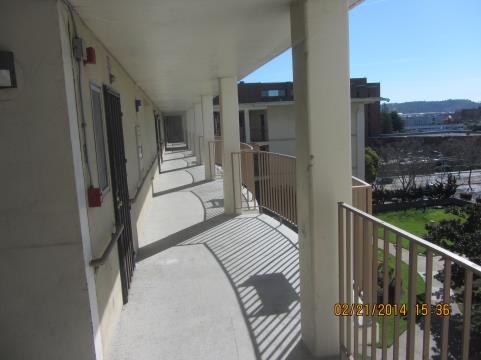Introduction
The 150-unit Hacienda is the ground zero poster child of Amy Julia Harris’ sensational expose of Richmond’s Housing Authority, so on Friday, February 21, I went to the scene of the crime to see for myself.
Resident Manager Debra Holter said she had been managing Hacienda for 16 years, and this was the first time, to the best of her knowledge, that a City Council member had visited the site. Tim Jones said he was sure this was the first time a City Council member had been on the roof.
For anyone reading this who doesn’t know my background, I have been a practicing architect for over 40 years. I am an expert in forensic architecture and evaluating the condition of buildings, including roofs, whole building evaluations and diagnostics.
As with my previous comments on this recent media frenzy about Richmond’s public housing, this is intended as neither a defense nor an excuse for any mismanagement at any level of the City of Richmond, but it is intended to provide a more circumspect portrayal of the complex and complicated nature of Richmond’s public housing program than that which has been portrayed in the press.
I would have expected better from the Center for Investigative Reporting and Amy Julia Harris, the author of a series of articles slamming the Richmond Housing Authority. While there is plenty to criticize about public housing in Richmond, I am disappointed that the effort by Harris as edited by Andrew Donohue, Mark Katches, Nikki Frick and Christine Lee, was oriented more toward sensationalism and hyperbole than toward objective reporting. There were also a number of factual errors, for which to date no correction or retraction has been offered.
The website of the Center for Investigative Reporting states, “Our work is fact-based, nonpartisan and truth-driven,” and “What keeps CIR alive isn't money or profit – it's impact.”
I submit that the spate of stories about Richmond are neither fact-based nor truth driven, and it appears the reporter was more after impact than reality.
They say don’t argue with people who buy ink by the barrel, but I think someone needs to take this group on. To me, it appears that they first chose a hypothesis and then and set out to hang whatever sensational narrative they could find to support it. The articles are:
The most egregious missing perspective is a chronology. Though still far from perfect, the Richmond Housing Authority has made significant progress in the last year to clean up its act, which HUD acknowledges, yet this fact is entirely missing from the coverage.
Most of the management criticisms in the articles were extracted from a HUD “PHARS Internal Summary of Assessment,” an internal memo dated June 18, 2012, largely based on 2011 data, which is by now old news. Shortly before the date of the memo, on April 12, 2012, HUD concluded an assessment of the Richmond Housing Authority and worked with the City to prepare a recovery plan which was provided by HUD on January 23, 2013. The Recovery Plan listed three areas of concern under governance and five areas of concern under finance designed to improve RHA’s financial position, increase their PHAS rating and ensure ongoing sustainability. Why is this noteworthy? Because as of January 23, 2013, when the Housing Commission (City Council plus two tenant representative) adopted the plan by resolution, any previous misconduct or mismanagement at the Richmond Housing Authority was water under the bridge, not necessarily justified or excused, but as far as HUD was concerned, it was history. It was time to move forward.
The CIR website says, “Since 1977, CIR has relentlessly pursued and revealed injustices that otherwise would remain hidden from the public eye.” When the Richmond Housing Authority Board/City Council adopted the Recovery Plan on February 5, 2013, all of the previous HUD critiques became public record. CIR would have us believe that thy uncovered this trove of secret documents and made them public.
Where is HUD?
One of the remedies discussed multiple times in the memo was to hire a management company to take over the Authority’s rental units. HUD likes to threaten this but is loath to actually do it because HUD knows how difficult it would be to find a contractor to operate the units for the insufficient funding provided.
Most conspicuous by its absence was any criticism by Harris of HUD, which entirely funds public housing and by any informed source, actually underfunds it by billions. Since 2010, public housing agencies have lost a cumulative total of $3.4 billion in federal funding (ignoring losses due to inflation) to operate and maintain public housing developments, which provide affordable homes to 1.1 million low-income families. These developments now face a $26 billion backlog of repair needs. While Tim Jones and his crew may have a number of shortcomings, any honest coverage of the problems in Richmond or anywhere else has to start with a lack of resources and unreasonable expectations (http://www.cbpp.org/cms/?fa=view&id=3993).
The CIR web site states:
Our stories reveal injustices and arm the public with the facts needed to spark federal legislation, policy change at all levels of government, public interest lawsuits, reforms in corporate practices, op-eds that move the needle of public opinion and more. CIR’s stories are at the center of news reports and community conversations.
Yet CIR never once cited HUD for inadequate funding or suggested any legislation or policy changes to address that issue. The entire focus was on the shortcomings of the Richmond Housing Authority and its staff.
The closest Harris got was quoting Jones about the funding issue, but she failed to evaluate whether or not he had a valid point, a very important, even critical, piece of information, particularly with respect to public policy.
“When I arrived, we had a staff of 65,” Jones said. “Now there’s a staff of about 28. We are lean here. There is no fat.”
The authority’s executive director, Tim Jones, said he’s “running an operation on life support.” He blamed years of budget cuts from the federal government for the problems plaguing the housing authority and insisted that the agency is on the road to recovery. He said the problems come down to money.
Rental Units and Finances
Harris also misrepresented the financial picture of the Richmond Housing Authority. She wrote:
The Richmond Housing Authority got $26 million in 2013 from the federal government to provide safe and decent housing for the needy. Richmond has 715 units of public housing for the poor, elderly and disabled. It also gives out Section 8 vouchers to subsidize rent for an additional1,750 residents on the private market.
Harris is inaccurate. The Richmond Housing Authority operates only 550 units, not 715. In FY 2012-13, the Richmond Housing Authority received $25,009,211 for all its programs. $20,561,276 of that went for Section 8 “Housing Choice Voucher Program,” leaving only $4,447,935 for other tasks. After other programs were accounted for, including HOPE VI, Project Real, Westridge and others, there was only a $3,293,293 subsidy available for public-operated housing rent subsidies, the subject of her reports.
The actual unit count is:
- Hacienda (150 units, built in 1966)
- Nevin Plaza (142 units, built in 1986)
- Friendship Manor (58 units, built in 1976)
- Triangle Court (98 units, built in 1987)
- Nystrom Village (102 units, built in 1942)
Hacienda
On February 21, I visited Hacienda to see for myself the disaster that Harris described. Tim Jones, Richmond Housing Authority director, and Debra Holter, resident manager, accompanied me. For a nearly 50-year old building, I was surprised at how good it looked, particularly in light of what Harris reported Tim Jones as saying:
Jones conceded that Hacienda is uninhabitable. He said the building should be torn down because “it just doesn’t make sense to put that much money into that structure.”
Jones said he is meeting with HUD soon to ask for permission to demolish or shut down Hacienda. HUD must sign off before the housing authority can give residents vouchers to find alternative housing.
I don’t know if Jones actually said that, but if he did, I disagree with him.
The Hacienda is an all-concrete structure and appears to be structurally sound. Concrete doesn’t rot, decay or support mold growth. The building may have seismic issues, but to my knowledge, no one has ever made a structural seismic evaluation. It is certainly no Pruitt-Igoe, and is not an unattractive building. It has wide entrance balconies with curved railings, large landscaped courtyards and great views. Apartments come in studios, 1-bedroom and 2-bedroom models. They are simple but clean.
The building needs a paint job and a new roof if HUD would pay for them. New windows would also be nice. I did not see any mice, rats, roaches or sewage leaks.

View to the north from a 6th Floor balcony

South Courtyard

Typical unit “turned” and ready for a new tenant

Bathroom in a typical unit “turned” and ready for a new tenant
The Hacienda Roof
Regarding the Hacienda roof, it is clearly a disaster. Harris wrote:
Federal inspectors in 2009 and then again in 2011 alsowarned of severe problems with the roof. In 2009, an entire electrical closet’s walls were “saturated with water mold and mildew” due to the leaking roof, they said. The housing authority has hired contractors to stop the roof from leaking since 2006, but it hasn’t gottenfixed. Even after the housing authority paid the most recent contractor $8,000 a few months ago, the roof still was leaking, according to a housing authority receipt. One contractor didn’t even finish the job years before, according to housing authority records.
What Harris did not say is that, according to Tim Jones, the roof dates from 1966, the original date of construction of Hacienda. It is approaching 50 years old, about 30 years past the normal service life of a built-up roof. The Richmond Housing Authority had tried unsuccessfully to patch it for years because it has not had sufficient funding from HUD to replace it.
For FY 2112-13, the capital budget for all of the Authorities projects, at least one dating back to 1942 was only $458,750, and a new roof at Hacienda at $347,000 would have taken almost the entire budget.
As I understand it, bid documents are currently being prepared for a new roof, which ideally, would be installed after the end of this rainy seaon.

The much repaired roof at Hacienda

Peeling ceiling finish in vacated 6th Floor apartment as a result ofroof leak
Cracks
In one of her articles of February 17, Amy Julia Harris wrote:
Cracks snake their way along the seams of Hacienda. In early January, reporters saw the walkway on Hacienda’s sixth floor separating from the main building by almost 2 inches. The cracks are so large that you can see down to the fifth floor. These were some of the same problems inspectors warned of years earlier.
In 2009, HUD noted that Hacienda’s foundation was separating from the walls. One- to 4-inch gaps were cited on all six floors, according to federal reports.
HUD officials gave the separated foundation its most extreme rating on the books. Major foundation problems can lead to the instability of an entire building. It’s unclear whether Richmond has a plan to make repairs.
I walked around the entire building and did not see any evidence of “foundation … separating from the walls.” I asked Jones and Holter if they knew where the cracks were. After pulling up the story on my iPhone and showing it to them, they realized the reference was to the building’s expansion joints. As an architect, I understand expansion joints, which are provided to avoid damage to the building from seismic shaking and from thermal expansion and contraction. They are not evidence of a structural problem; quite the contrary, they are part of the structural design. That a HUD inspector did not know this makes HUD’s credibility suspect.
The expansion joints have not been maintained, but they are not indications of any structural defect or hazard.

Seismic/expansion joint with staining from leaking roof above
The Hacienda Residents
I wanted to talk to some of the residents to get a feeling about their experiences at Hacienda.
Rhonda Marshall
The first tenant I spotted was Rhonda Marshall. Here is what Harris wrote about Marshall:
There are a dozen light posts in Hacienda’s courtyard, but for more than two years, none worked. At night, Rhonda Marshall stumbled in her wheelchair getting from her apartment to a back gate across the courtyard, rolling off uneven paths in the darkness. “It’s so dark you can’t see your hands in front of you,” the 58-year-old said.
Rhonda Marshall, 58, waves to visitors outside the Hacienda public housing complex. She’s been living on the high-rise’s first floor for years and has watched the building deteriorate. She says she sees cracks in the walls running from the sixth floor to the ground and smells mold in the hallways and stairwells. (Lacy Atkins/San Francisco Chronicle)
At the time, I had not recalled that Harris had featured Marshall in one of her stories. I greeted Rhonda, introduced myself and simply asked her, “How do you like living here, Ms. Marshall?”
She responded:
“Love it, my place is a mansion”
I asked her if she had any problems with her unit. She said she had a problem with her door but that someone would fix it next week. She said she knew Mr Jones didn’t have enough money to take care of everything. She said she loves the new garden crew and has “no critters” in her unit. She thought the “critters” some people had complained about might come from the garbage chutes, which are not cleaned as often as they used to be. Then she added, “They didn’t feed us Thanksgiving and Christmas dinner this year.”
Later, Jones told me that dinner had been served to over 100 tenants by a church, but for some reason, Mitchell didn’t get the word or didn’t attend.

Geneva Eaton
I wanted to talk to one of the tenants who had been prominently featured by Amy Julia Harris, so I knocked on the door of Geneva Eaton. She let me in, and I asked her to show me any problems in her unit. She showed me a light in the refrigerator that was dangling out of its housing, a cracked vinyl floor tile, a missing threshold strip under the bathroom door, and an area on her screen door where the mesh was separating from the frame. While I was there, a woman who identified herself as a Chronicle reporter hovered outside the door snapping photos of us.

Geneva Eaton


Cracked vinyl floor tile in Geneva Eaton’s unit (note full dog food bowls)

Dangling light bulb in refrigerator in Geneva Eaton’s unit

Missing threshold strip under door in Geneva Eaton’s unit

Screen separated from door frame Geneva Eaton’s unit
Here is what Harris wrote about Eaton:
Geneva Eaton has learned to deal with life in Hacienda: the stench of mold from the stairwell in front of her door, the winter she spent huddled at her stove for heat, the broken security gate that allows drug dealers and squatters to walk past the paid security guards and urinate on her doorstep. But the mice were too much.
For eight months, the 73-year-old woke to handfuls of half-dead mice wriggling in the glue traps lining the floors and cupboard of her apartment. In the space of a few hours, she caught 12. She put her nicest family belongings into storage. She went to bed with the lights on, afraid that the vermin she heard chewing through her walls would bite her in her sleep.
When I was there, Eaton said that she had no roaches, mold or mice. I did notice that she had two bowls permanently filled with dog food on the floor, which might have had something to do with her mouse problem.
Later I asked Debra Holter to check into the status of Geneva Eaton’s complaints, and she responded later by email after checking the work order files:
Per your request, I have checked the work order system and I do not have any open work orders for Ms. Geneva Eaton of 1300 Roosevelt, #407. The last work order that Ms. Eaton requested was on December 12, 2013 for no heat, the work order was completed on December 13, 2013.
Diana Garcia
The next door I knocked on at random was the unit of Diana Garcia. Diana told me that she had loved there five years, and the only concern she had was a woman who lived on the floor below her, a Ms. York, who had hit her sometime in the past. She seemed to be concerned that it could happen again.
When I pressed Diana again about problems in her unit, she told me that her tub faucet had been leaking. She said she had not made maintenance request but was “going to.”
When I asked Tim Jones and Debra Holter about York, they told me that she had recently died and that “her funeral is today” (February 21). I resisted the urge to go back and inform Diana.
Otis Williams
When queried about problems, Otis said he had a leaking faucet but had not called yet for maintenance. He had no comments one way or another about living at Hacienda.
Evan Lang
The final person I interviewed was Evan Lang. Evan said he did not like living at Hacienda but that things were much better since he moved from a fourth floor unit where mold was bothering him. He showed me a letter from his doctor. Regarding his current unit, he showed me his bedroom door that dragging on the floor and would not close all the way and a window that was racked and would not fully close. He also noted that the elevator was broken. He acknowledged that the management had promised him that his door and window would be repaired in a couple of days.

Evan Lang’s stuck bedroom door

Evan Lang’s window
Hacienda Maintenance
I was curious about the maintenance issues and asked Tim and Debra to explain how the maintenance system works. I was under the impression that the Housing Authority had a maintenance staff, but that is not the case. Due to funding constraints, there is no maintenance staff. Other than for a dire emergency, routine repair and maintenance requests are “bundled” and submitted for bids to a group of regular contractors. This process takes about a couple of weeks, so there is typically a delay of from days to weeks from the time a work order is placed until it is acted on.
In the case of an emergency, a contractor can be dispatched within 24 hours.
Jones and Holter said that a lot of the perceptions of inattention stem from tenants’ not using the system correctly. They showed me a notice in the Lobby detailing how the process works. Often a tenant will simply not get around to placing a work order, as acknowledged by several to whom I talked. Sometimes they will make a complaint to a contractor who has come to repair something else, not understanding that the contractor is not part of the staff and has no authorization to repair anything other than what he has contracted for. Sometimes, tenants think they have reported a problem but actually have not.

Two days ago, City Manager Bill Lindsay followed up on some information provided by Harris:
"I visited Hacienda recently and there was a woman on the fourth floor who described how she had a bathtub full of roaches for months--I didn't see the roaches personally. But her story wasn't unique. There was another resident on the fifth floor who got trapped in the elevator this weekend as well, and has had dirty water bubbling up into her sink for weeks. Her name is _________. A resident on the sixth floor (unit XXX) is struggling with mold and roaches."
Lindsay then contacted Tim Jones on Friday evening to have him follow up immediately. His maintenance staff got back to him this morning with the following information:
I checked the work order request line and also looked for any open work orders for ___________ (HAC XXX), there is nothing in either. The last work order for Ms. ____ was a heater problem repaired on February 7, 2014 there was no sink stoppage problem at that time. I spoke with Allen and he stated he did not know of anyone getting "stuck" in the elevator over the weekend. As you know we are having door problems and ThyssenKrupp has been out no less than 6 times last week to repair intentional damages to the elevators. I personally rode up in the elevator with Ms. ______on Thursday, February 20, 2014 and she never stated anything to me about getting stuck or having a sink problem. Will create work order to have it checked on Monday. Ms. _____ is usually pretty good about calling in a work order.
I spoke with Debby yesterday morning and Ms. _____ is the next to be transferred from a 1 to a 2 bedroom due to a live in aide. Maria and Kathleen were off and this will be brought to their attention and if approved Apt. #401 can be offered to her. Debby does not have anyone on a 2 bedroom senior/disabled wait list.
Ms. ______(HAC XXX) has not called in a work order for roaches since November 6, 2013, she was treated on November 8, 2013. She was also treated on January 17, 2014 when the entire building was offered treatment. She does have a work order in for mold in unit dated February 13, 2014. Allen went to the unit and it was very hot inside and a lot of condensation on the windows, Allen informed Ms. _______ she needed to open her windows to allow for ventilation and air circulation, she said since she did not have screens she did not want to, Allen told her he would locate some screens for her windows. There is a little bit of mold in the corner of her kitchen ceiling by the front door, Allen went to take pictures but tenant would not let him in and told him to come back later.
These incidents are evidence that the RHA is attentive to residents’ complaints, getting accurate information continues to be difficult.
Hacienda Security
Security at Hacienda starts with the building itself. It is surrounded by an 8-foot high steel security fence, and access to the building by non-tenants is only if a tenant buzzes someone in. a contractor, Cypress Security, provides a security guard 24/7 the first week of every month, because that is when tenants get various support checks and are most vulnerable. After that, security is reduced to 12 hours a day, during the nighttime. Lack of funding from HUD prevents enhanced security.
There is no operating video surveillance system at the Hacienda. What exists is inadequate but is broken anyway. People who should not be in the building gain access by following someone else in, being let in by a tenant or a tent’s family member, or by scaling the security fence.
The Housing Authority is in the process of terminating Cypress based on reports of serious lapses.
Hacienda Grounds and Landscaping
The building grounds are generally well-maintained, with one exception. The area west of the building landscaped with ivy ground cover and not intended for tenant use is strewn with trash and broken glass, including drug paraphernalia. This needs to be cleaned up.

Other Issues
Meals
In a journalistic “gotcha,” Harris described what she made to appear as a $400 meal consumed by Tim Jones, himself, in New York:
In a trip to New York in November 2009, Jones got the authority to pay for a $417.34 meal at Fabio Piccolo Fiore, a high-end Italian restaurant, HUD documents show. In Washington, he had taxpayers fund $130.60 and $279.90 meals at an upscale soul-food restaurant called Georgia Brown’s in 2008 and 2010.
Its executive director, Tim Jones, charged hundreds of dollars on meals in New York and Washington, including a roughly $400 meal at an upscale midtown Manhattan restaurant where a strip steak with truffle fries runs $41.
HUD found the charges to be excessive, according to a review that stretched from 2008 to 2011. In addition to charging the meals, Jones appears to have billed taxpayers a $40 stipend each day he traveled, records show. Government officials are supposed to limit their meals to the per diem costs, so they shouldn’t be charging meals at all.
Based on information I obtained from the city manager and from Jones himself, the New York meal in question was a working session by at least five people, maybe more, representing LISC (Local Initiatives Support Corporation), NURVE and the City of Richmond, who were in New York to make a presentation on Richmond’s NURVE Project. “NURVE” stands for “Nystrom Urban ReVitalization Effort” a partnership of several foundations and public agencies, including the Richmond Housing Authority, which are dedicated to revitalizing one of Richmond’s most challenging communities. Already to date, NURVE’s partners have raised nearly $50 million dollars for projects, half of which are built or under construction.
Harris extracted all the information about meals from an unverified HUD report without fact-checking it.
REAC Scores
HUD routinely conducts “REAC” program inspections of public housing properties. According to HUD, “The Real Estate Assessment Center's (REAC) mission is to provide and promote the effective use of accurate, timely and reliable information assessing the condition of HUD's portfolio; to provide information to help ensure safe, decent and affordable housing…”
Below are the Scores from the REAC inspection reports for the Richmond Housing Authority properties for 2012, which were the most recent REAC inspections performed. There are two scores. The first might be considered the “base” score for the property on a scale of 0 to 100. Then, there are Health and Safety “deducts” from the base score based on observed repairs. In essence, the H&S deducts are similar to “fix it tickets” that a car driver might receive when a tail light our a turn signal is inoperative. They are considered temporal (rather than structural ) in nature. As applied for the REAC program, a life safety H&S might include having a low battery in a smoke alarm. As a practical matter, the RHA prepares a work order for each H&S deduct and fixes the problem immediately.
As you can see from the reports, the base scores, deducts and net scores for the properties for 2012 are as follows:
| Property | Base Score out of 100 | Deducts | Net Score |
| Nystrom Village | 95.7 | 17.7 | 78 |
| Hacienda | 81.8 | 5.8 | 76 |
| Friendship Manor | 93.6 | 14.7 | 79 |
| Triangle Court | 93.6 | 16.9 | 77 |
| Nevin Plaza | 67.0 | 13.7 | 67 |
As indicated, three of the five properties scored well into the 90’s on a 100 point scale for their base score. According to Tim Jones, all “deducts” to these base scores were immediately repaired after the REAC inspection. You may also note from the backup to the attached reports that the REAC inspection is rigorous. For example, Nevin Plaza (the lowest base score) received 0 points for the exterior section out of a possible 16.4 points because of three items: the exterior door to the trash room did not close automatically, there was a “bad seal” due to inadequate caulking at an office, and there was a damaged downspout from the roof.
Summary
The condition and operation of public housing in Richmond is clearly less than desirable, but the reality is not nearly as bad as Amy Julia Harris portrays it. Likewise, the causes of any deficiencies are much more complex and the blame wider than Harris would have us believe. The Center for Investigative Reporting must think they have done a great service by taking on Richmond’s public housing, but what they have done borders on yellow journalism, striving for sensationalism while ignoring both reality and the bigger picture. What they also haven’t done is describe what is needed to fix it.
Writing a critical article about anything is easy, but operating a government is not. There are problems everywhere in Richmond as in any city: potholes, crime, pollution, education, unemployment and public transportation, to name a few. It’s easy to blame any or all of these on government mismanagement and incompetent pubic employees. But the public gives their government only so much money with which to operate and then leaves it to legislators and administrators to decide how to allocate it. There is never enough to go around.
Neither is poor management and poor judgment a flaw limited to the public sector. The private sector has their share. Chevron’s gross negligence resulted in a devastating fire at the Richmond Refinery in 2012, and when their fracking operation blew up in Pennsylvania last week, they assuaged the community’s trepidation with free pizza and a soda.
As a City Council member, I am committed to do whatever we can, as the governing body, to make the Richmond Housing Authority better or to perhaps to simply turn it over to HUD since they seem to have all the answers.
| | | < RETURN |



















